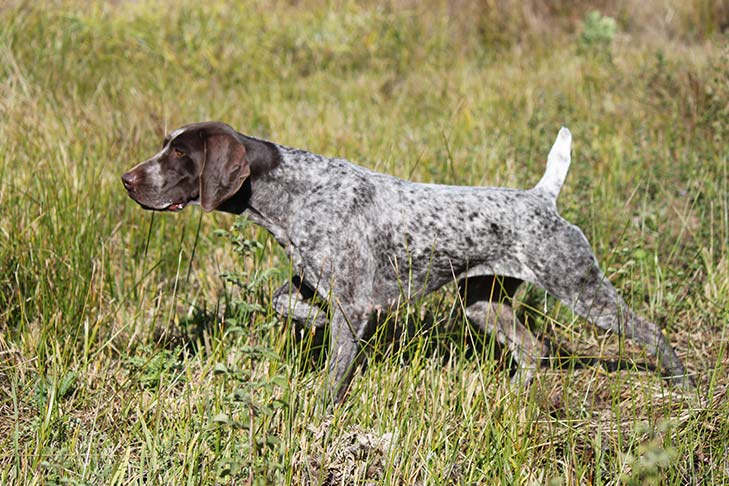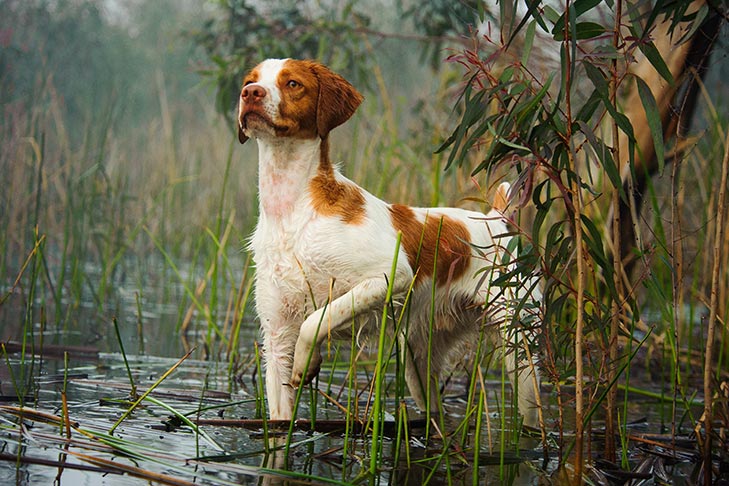Clubs Offering:
|
You’re out for a walk with your dog or perhaps just playing in the yard. Suddenly, the dog stops cold. Freezing in place, their nose straightens, their tail lifts out, and they stare intently in one direction. Almost robotically, one front foot lifts slightly off the ground and bends up in a point.
Graceful and precise, this stance isn’t accidental. Why do dogs seem to mimic statues?
In fact, pointing is a longtime instinct. Hunting dogs purposely-bred for generations used the tactic to help owners hunt game and put food on the table.
Although you may not need your dog to find meals, he might strike a pose with a paw folded and suspended in air if he senses something moving.
“If he’s a Pointer, he’s picking up a scent and raising one foot to point in the direction he smells prey,” says Diane Townsend, president of the American Pointer Club. “There’s nothing more natural in this breed than to point.”
When dogs position themselves like this, they’re alerting the owner that a bird or small game is close. By sniffing the air, the dog detects the animal’s scent drifting on wind currents.
Other AKC pointing breeds specifically bred and trained for hunting for generations in Europe or Great Britain will hold the same point position. These include, among others:

Pointing breeds aren’t the only dogs who stop in their tracks and lift a paw when they see a bird, squirrel, or rabbit. Other breeds or mixed-breeds who are driven by a need to spot moving objects often show a variation on the traditional point.
Some dogs freeze in place without lifting his paw, nose, or tail. Others might lock their eyes on a small animal before chasing, capturing, or breaking the prey’s neck to kill it.
Where does this courageous and high-spirited trait come from? A possible reason is that some ancestor in the dog’s heritage was a pointing breed.
“Dogs are known for stopping, pouncing, and eating their prey, but what’s different about a specific hunting breed is its ability to work as a partner with their owner,” says Sharon Fitzpatrick, president of the German Shorthaired Pointer Club of America. “Pointing breeds can search for upland game birds or small prey away from their handler, yet follow instructions when the handler arrives.”
Usually independent thinkers able to find the solution to a problem, pointing breeds work in all types of terrain and weather. According to Townshend, they can be capable of pointing at just 2 months old without ever having to be taught.
Piper, a 4-year-old Vizsla owned by Lynn Brelie-Garel, points and stalks anything that moves.
“She began pointing when she was nearly a year old,” Brelie-Garel says. “Today she’ll stare at lizards, bunnies, and birds. Piper isn’t picky.”
Squirrels drive Sandra Smythe’s 2-year-old Dalmatian, Poppy, bonkers.
“When she’s inside the house, Poppy stands at the sliding glass door and looks in the yard,” says the St. Paul, Minnesota, resident. “If she sees a squirrel, she tears through the doggy door and runs full-speed after it.”
For owners who want to pursue an AKC Master Hunter or Field Trial title with their dogs, some training is required. Many dogs can earn a Junior Hunter title without much training, but advanced skills for hunt tests usually need some sharpening.

Every dog has its own pointing position characteristics. However, handlers must learn how to read a dog’s body language to understand what the dog is communicating.
“If the tail is moving, this might mean the bird is moving,” says Fitzpatrick. “Or, the exact position of the head, whether up or slightly down, can indicate how far the bird might be. Pointing breeds also know the difference between a songbird or a game bird, which helps if the hunter is looking for food.”
Need some help training your dog? While you may not be able to attend in-person training classes during COVID-19, we are here to help you virtually through AKC GoodDog! Helpline. This live telephone service connects you with a professional trainer who will offer unlimited, individualized advice on everything from behavioral issues to CGC prep to getting started in dog sports. https://www.akc.org/wp-admin/admin-ajax.php Get Your Free AKC eBook
Find food that fits your pet’s needs
Have you ever looked at your pup in confusion as he stood, stock-still, staring at something only he could see? This behavior is called pointing. Why do dogs point? Can any breed of dog be taught to point? Pointing isnt often a skill pet parents teach their pups, but teaching him this special skill may have its benefits.
Do German Shorthaired Pointers Point Naturally?
German Shorthaired Pointers are energetic dogs who trust their instincts more than anything. They are natural pointers, courtesy of generations of hunting, and can easily sniff out raccoons, rabbits, deer, etc.
GSPs don’t need hardcore training to point; it is an instinct embedded in their minds from an early age. When a German Shorthaired Pointer detects prey, they lower their heads while slowly lifting a front paw to indicate the direction of the target, all without breaking their gaze from it.
Pointing is a practice dogs use when they sense a quarry and need to inform the hunters without alerting or scaring the prey. They usually do this by freezing their bodies and gazing hard at their prey, as if anticipating it, and raising a paw, like an arrow, to point.
Their instinct to the point didn’t develop overnight- they owe it to generations of GSPs that perfected their hunting skills day and night on hunt. Today, through evolution, GSPs have a natural instinct to sniff out the game in the blink of an eye.
Hardcore training isn’t required for pointing; however, GSPs need to be subjected to simulations to test their abilities. Mental and physical exercise can help maintain their wit and naturally help them to test their limits.
Pointer Dog – Top 10 Facts
The excitement associated with seeing a dog on point is likely what attracted most pointing dog owners. What is the pointing instinct, exactly, and how does it develop?
The pointing instinct. Pointing is defined as freezing at the scent or sight of game. It is an inherited instinct most prominent in the pointing breeds but, to some degree, many sporting breeds and wild animals also display the pointing instinct.
Two terms are frequently used to describe points. Staunchness refers to how long the dog holds point while steadiness describes a level of training, i.e., steady-to-wing or steady-to-wing-and-shot.
Puppy points. A puppy’s first points are usually an instinctive response to the smell of game. These points are often called “flash points” and are short in duration. Some puppies, though, do point for a longer time because they’re unsure and aren’t bold enough to rush in. During these early points, the puppy is in a heightened state of emotion, its body posture intense and sometimes crouched as it focuses exclusively on the smell.
As a puppy learns what it is smelling, it points and then stalks toward the location of scent until it gets close enough to flush the bird. The puppy chases to try to catch the bird. This continues until the puppy realizes it can’t catch the bird and, therefore, its only alternative is to hold point. As the puppy becomes more experienced in pointing, the excitement wanes and its pointing stature begins to convey confidence and boldness.
Developing point. To properly develop a young pointing dog, it should be allowed to learn how to handle birds without interference. The best method is frequent bird (wild or liberated birds that can’t be caught) contacts. Two of the most important lessons are learned at this stage—how close the dog can get to the bird before the bird flushes and that the dog’s movement causes the bird to flush. (For more information, please view the post Accuracy of location.)
There is nothing the handler can do—or should do—to rush this phase. While the puppy is pointing, don’t talk to or restrain it and don’t be in a hurry to flush the bird.
Staunchness and steadiness training. At some time, and after enough bird contacts, most well-bred pointing dogs naturally stay on point until the handler arrives. This is the minimum expected (the hunter needs to be close enough to shoot the bird) and is referred to as a staunch point or staunchness.
The next step is steadiness training. Many pointing dogs are trained to be steady to the flush of a bird, also called steady-to-wing. Very few are trained to the ultimate level–steady-to-wing-and-shot.
Pointing problems. Faulty genetics, improper development, bad training or a combination can cause problems with pointing. Here are some of the most common and their causes.
Blinking The dog smells the bird but then avoids it and continues on. This is almost always a man-made fault from improper development around game. While some dogs may be soft tempered by nature, no dog is born a blinker.
Bumping Whether before or after pointing, the dog intentionally jumps in and causes the bird to flush. This is fine in a young dog but should not be allowed in a mature dog. These are usually bold, aggressive dogs that need to be corrected.
Circling The dog smells the bird and maybe points but then tries to move around the bird instead of going directly towards it. In a mature, experienced wild bird dog, this behavior might be a learned response to stop birds from running away from its points. Circling in a young dog, however, is more likely an inherited behavior but could be caused by improper training and development.
Flagging The dog points the bird but its tail wags and never stiffens. This can be inherited and/or man made.
Laying down A dog points with low posture or even lies down on point shows a lack of boldness towards the bird and/or doesn’t want the bird to flush. This can be inherited and/or man made.
Unproductive points The dog points and but no bird is flushed. Again, this can be inherited and/or man made. (For more information, please view the post Unproductive points.)
Final thoughts. • Sight points are not the same as scent points. The old “wing on a string” trick so often used to pick a pointing dog puppy means nothing regarding future scent-pointing ability. • All dogs will tend to point longer as they get older. Too, they get more cautious in the presence of game. • There is “too much point” and “not enough point.” Ideally, the young dog will have enough genetic point to stop but learn staunchness through bird contacts. • A precocious puppy with excessive staunchness doesn’t always turn into the best wild bird dog in the end.